Abstract
Some difficulties with the classical model for the evolution of a genetically invert Y chromosome are discussed. An alternative model is proposed, which is based on the principle of Mullers ratchet; this involves the accumulation of chromosomes bearing deleterious mutant genes in a finite population in the absence of crossing-over. This process would result in the gradual increase, with time, in the number of mutant loci carried in an average Y chromosome, although the frequency of individual deleterious alleles at most loci remains low. It is shown that this creates a selection pressure for differentially increasing the activity of the X chromosome in heterogametic individuals at the expense of that of the Y, leading eventually to a genetically inert Y chromosome and to the evolution of dosage compensation.
Full text
PDF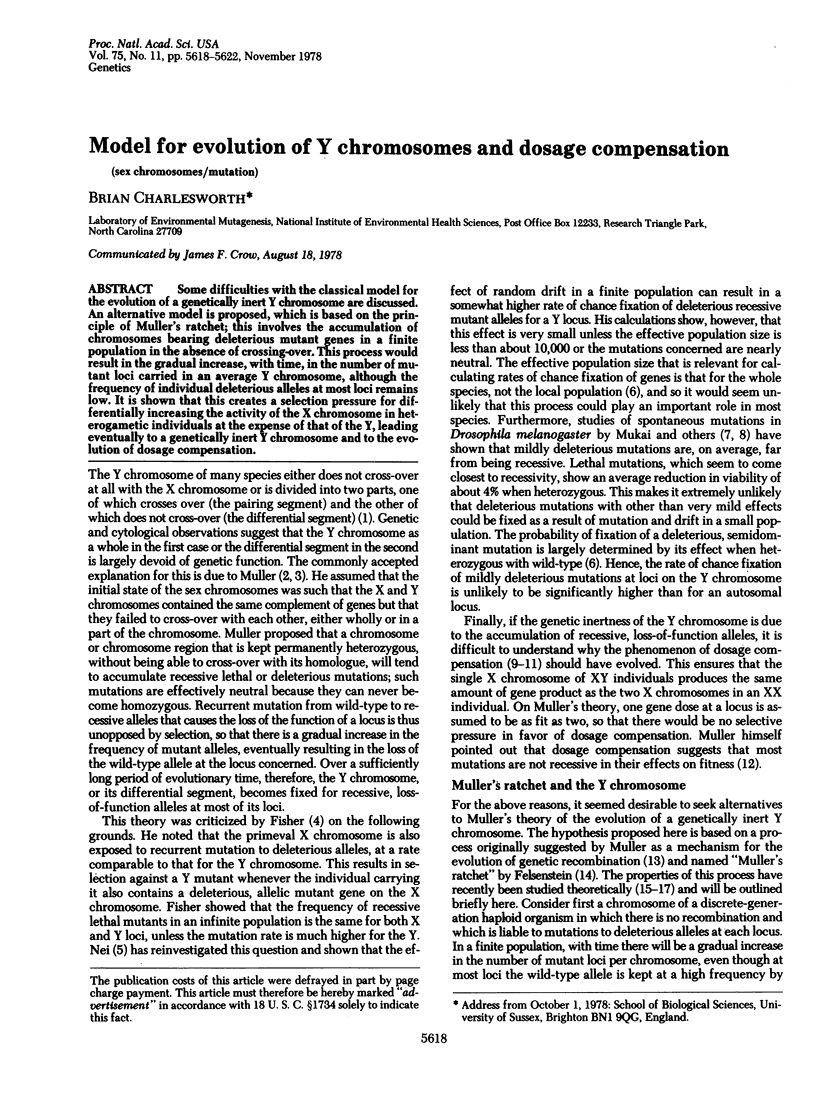
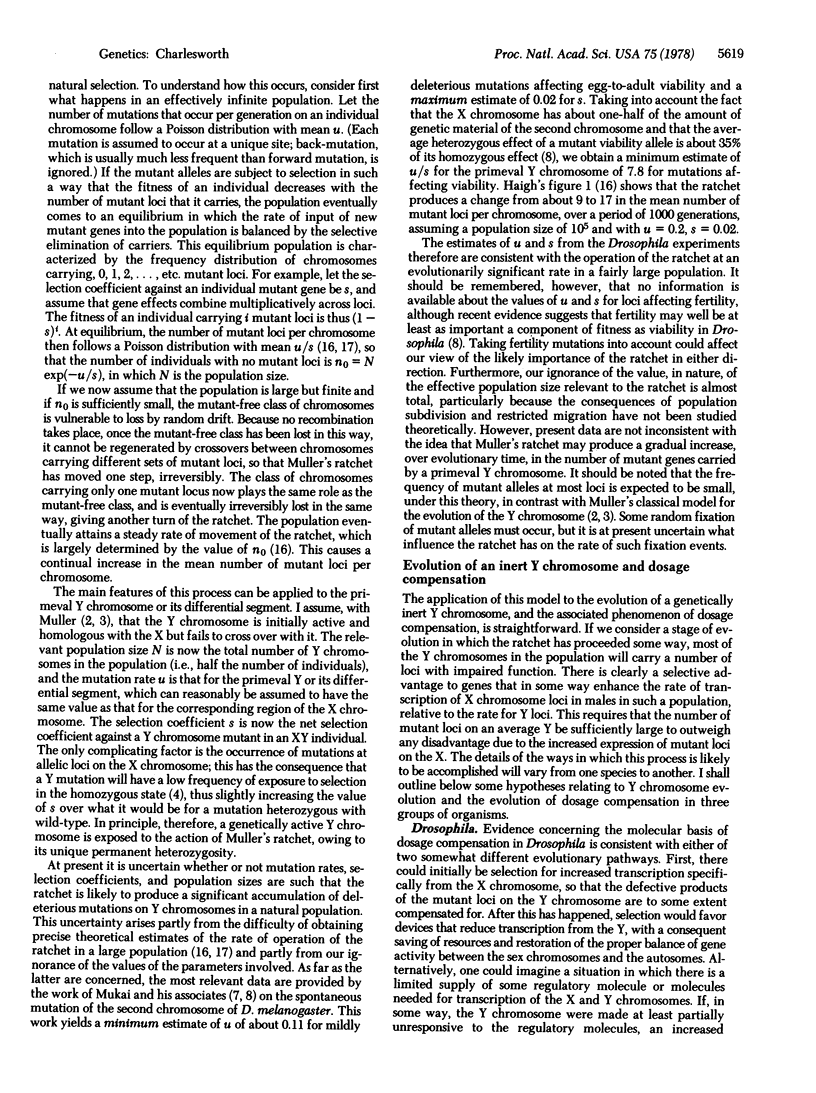
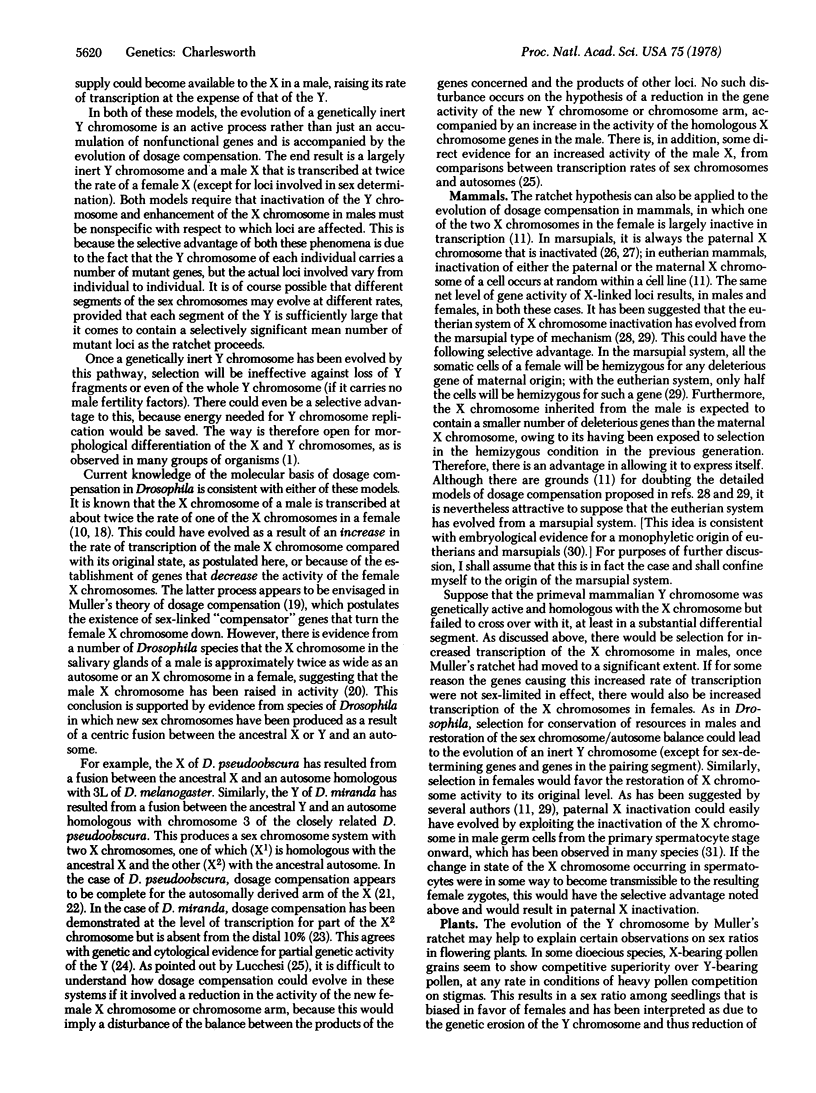
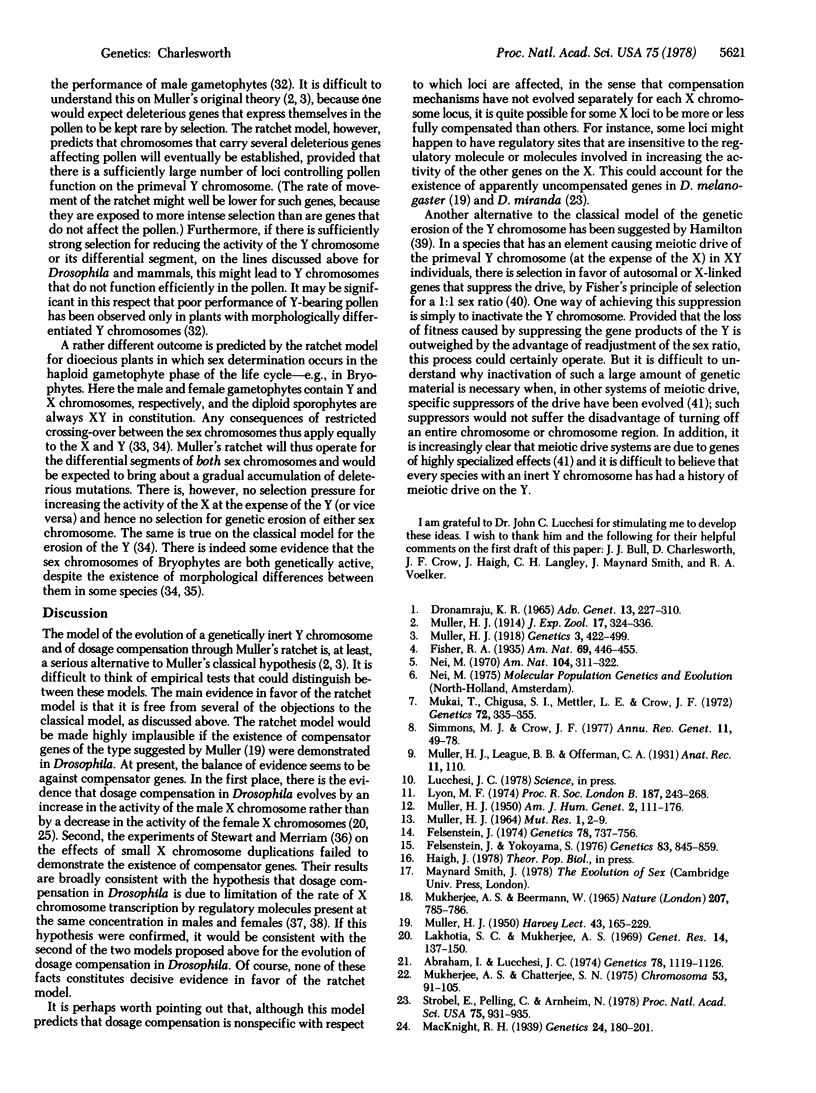
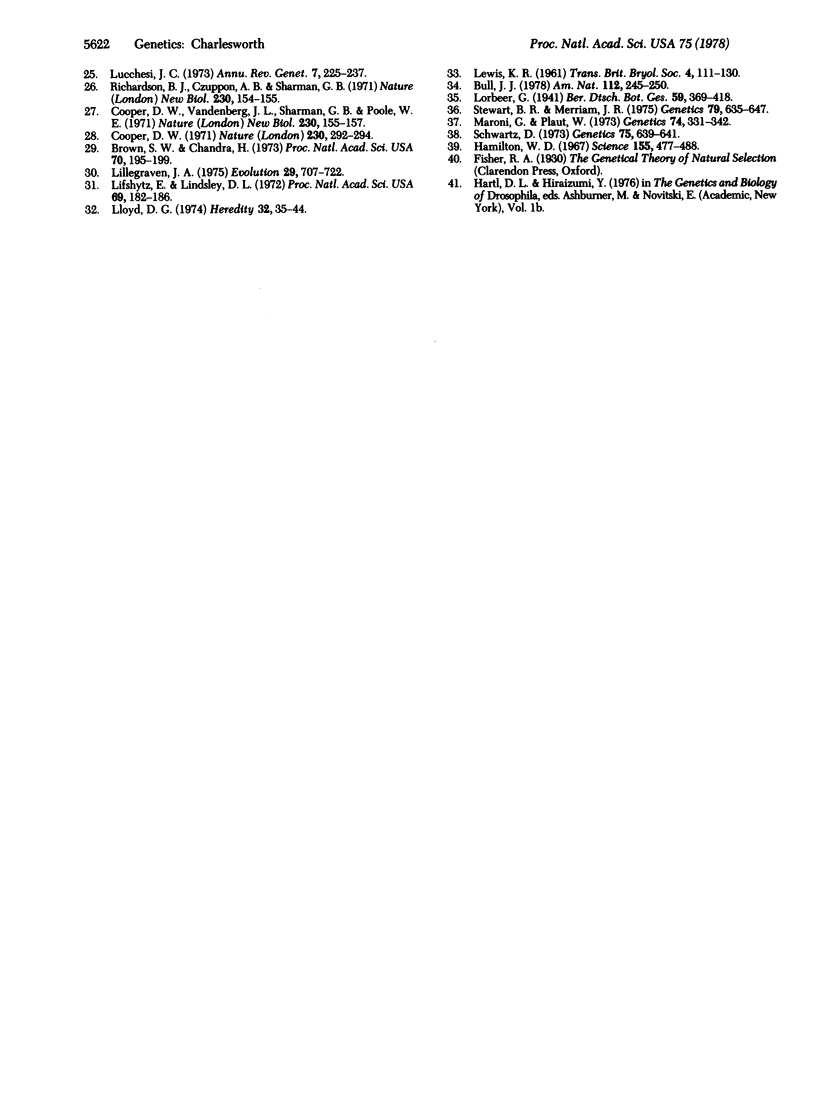
Selected References
These references are in PubMed. This may not be the complete list of references from this article.
- Abraham I., Lucchesi J. C. Dosage compensation of genes on the left and right arms of the X chromosome of Drosophila pseudoobscura and Drosophila willistoni. Genetics. 1974 Dec;78(4):1119–1126. doi: 10.1093/genetics/78.4.1119. [DOI] [PMC free article] [PubMed] [Google Scholar]
- Brown S. W., Chandra H. S. Inactivation system of the mammalian X chromosome. Proc Natl Acad Sci U S A. 1973 Jan;70(1):195–199. doi: 10.1073/pnas.70.1.195. [DOI] [PMC free article] [PubMed] [Google Scholar]
- Cooper D. W. Directed genetic change model for X chromosome inactivation in eutherian mammals. Nature. 1971 Apr 2;230(5292):292–294. doi: 10.1038/230292a0. [DOI] [PubMed] [Google Scholar]
- Cooper D. W., VandeBerg J. L., Sharman G. B., Poole W. E. Phosphoglycerate kinase polymorphism in kangaroos provides further evidence for paternal X inactivation. Nat New Biol. 1971 Mar 31;230(13):155–157. doi: 10.1038/newbio230155a0. [DOI] [PubMed] [Google Scholar]
- Dronamraju K. R. The function of the y-chromosome in man, animals, and plants. Adv Genet. 1965;13:227–310. [PubMed] [Google Scholar]
- Felsenstein J. The evolutionary advantage of recombination. Genetics. 1974 Oct;78(2):737–756. doi: 10.1093/genetics/78.2.737. [DOI] [PMC free article] [PubMed] [Google Scholar]
- Felsenstein J., Yokoyama S. The evolutionary advantage of recombination. II. Individual selection for recombination. Genetics. 1976 Aug;83(4):845–859. doi: 10.1093/genetics/83.4.845. [DOI] [PMC free article] [PubMed] [Google Scholar]
- Hamilton W. D. Extraordinary sex ratios. A sex-ratio theory for sex linkage and inbreeding has new implications in cytogenetics and entomology. Science. 1967 Apr 28;156(3774):477–488. doi: 10.1126/science.156.3774.477. [DOI] [PubMed] [Google Scholar]
- Lakhotia S. C., Mukherjee A. S. Chromosomal basis of dosage compensation in Drosophila. I. Cellular autonomy of hyperactivity of the male X-chromosome in salivary glands and sex differentiation. Genet Res. 1969 Oct;14(2):137–150. doi: 10.1017/s001667230000197x. [DOI] [PubMed] [Google Scholar]
- Lifschytz E., Lindsley D. L. The role of X-chromosome inactivation during spermatogenesis (Drosophila-allocycly-chromosome evolution-male sterility-dosage compensation). Proc Natl Acad Sci U S A. 1972 Jan;69(1):182–186. doi: 10.1073/pnas.69.1.182. [DOI] [PMC free article] [PubMed] [Google Scholar]
- Lucchesi J. C. Dosage compensation in Drosophila. Annu Rev Genet. 1973;7:225–237. doi: 10.1146/annurev.ge.07.120173.001301. [DOI] [PubMed] [Google Scholar]
- Lyon M. F. Mechanisms and evolutionary origins of variable X-chromosome activity in mammals. Proc R Soc Lond B Biol Sci. 1974 Nov 5;187(1088):243–268. doi: 10.1098/rspb.1974.0073. [DOI] [PubMed] [Google Scholar]
- MULLER H. J. Our load of mutations. Am J Hum Genet. 1950 Jun;2(2):111–176. [PMC free article] [PubMed] [Google Scholar]
- MULLER H. J. THE RELATION OF RECOMBINATION TO MUTATIONAL ADVANCE. Mutat Res. 1964 May;106:2–9. doi: 10.1016/0027-5107(64)90047-8. [DOI] [PubMed] [Google Scholar]
- Macknight R H. The Sex-Determining Mechanism of Drosophila Miranda. Genetics. 1939 Mar;24(2):180–201. doi: 10.1093/genetics/24.2.180. [DOI] [PMC free article] [PubMed] [Google Scholar]
- Maroni G., Plaut W. Dosage Compensation in DROSOPHILA MELANOGASTER Triploids. II. Glucose-6-Phosphate Dehydrogenase Activity. Genetics. 1973 Jun;74(2):331–342. doi: 10.1093/genetics/74.2.331. [DOI] [PMC free article] [PubMed] [Google Scholar]
- Mukai T., Chigusa S. I., Mettler L. E., Crow J. F. Mutation rate and dominance of genes affecting viability in Drosophila melanogaster. Genetics. 1972 Oct;72(2):335–355. doi: 10.1093/genetics/72.2.335. [DOI] [PMC free article] [PubMed] [Google Scholar]
- Mukherjee A. S., Beermann W. Synthesis of ribonucleic acid by the X-chromosomes of Drosophila melanogaster and the problem of dosage compensation. Nature. 1965 Aug 14;207(998):785–786. doi: 10.1038/207785a0. [DOI] [PubMed] [Google Scholar]
- Mukherjee A. S., Chatterjee S. N. Chromosomal basis of dosage compensation in Drosophila VIII. Faster replication and hyperactivity of both arms of the X-chromosome in males of Drosophila pseudoobscura and their possible significance. Chromosoma. 1975 Nov 24;53(2):91–105. doi: 10.1007/BF00333038. [DOI] [PubMed] [Google Scholar]
- Muller H J. Genetic Variability, Twin Hybrids and Constant Hybrids, in a Case of Balanced Lethal Factors. Genetics. 1918 Sep;3(5):422–499. doi: 10.1093/genetics/3.5.422. [DOI] [PMC free article] [PubMed] [Google Scholar]
- Richardson B. J., Czuppon A. B., Sharman G. B. Inheritance of glucose-6-phosphate dehydrogenase variation in kangaroos. Nat New Biol. 1971 Mar 31;230(13):154–155. doi: 10.1038/newbio230154a0. [DOI] [PubMed] [Google Scholar]
- Schwartz D. The application of the maize-derived gene competition model to the problem of dosage compensation in Drosophila. Genetics. 1973 Dec;75(4):639–641. doi: 10.1093/genetics/75.4.639. [DOI] [PMC free article] [PubMed] [Google Scholar]
- Simmons M. J., Crow J. F. Mutations affecting fitness in Drosophila populations. Annu Rev Genet. 1977;11:49–78. doi: 10.1146/annurev.ge.11.120177.000405. [DOI] [PubMed] [Google Scholar]
- Stewart B. R., Merriam J. R. Regulation of gene activity by dosage compensation at the chromosomal level in drosophila. Genetics. 1975 Apr;79(4):635–647. doi: 10.1093/genetics/79.4.635. [DOI] [PMC free article] [PubMed] [Google Scholar]
- Strobel E., Pelling C., Arnheim N. Incomplete dosage compensation in an evolving Drosophila sex chromosome. Proc Natl Acad Sci U S A. 1978 Feb;75(2):931–935. doi: 10.1073/pnas.75.2.931. [DOI] [PMC free article] [PubMed] [Google Scholar]


